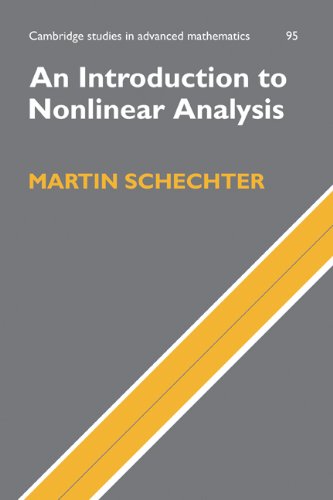

Most ebook files are in PDF format, so you can easily read them using various software such as Foxit Reader or directly on the Google Chrome browser.
Some ebook files are released by publishers in other formats such as .awz, .mobi, .epub, .fb2, etc. You may need to install specific software to read these formats on mobile/PC, such as Calibre.
Please read the tutorial at this link: https://ebookbell.com/faq
We offer FREE conversion to the popular formats you request; however, this may take some time. Therefore, right after payment, please email us, and we will try to provide the service as quickly as possible.
For some exceptional file formats or broken links (if any), please refrain from opening any disputes. Instead, email us first, and we will try to assist within a maximum of 6 hours.
EbookBell Team

4.0
76 reviews
ISBN 10: 0521843979
ISBN 13: 9780521843973
Author: Martin Schechter
The techniques that can be used to solve non-linear problems are far different than those that are used to solve linear problems. Many courses in analysis and applied mathematics attack linear cases simply because they are easier to solve and do not require a large theoretical background in order to approach them. Professor Schechter's 2005 book is devoted to non-linear methods using the least background material possible and the simplest linear techniques. An understanding of the tools for solving non-linear problems is developed whilst demonstrating their application to problems in one dimension and then leading to higher dimensions. The reader is guided using simple exposition and proof, assuming a minimal set of pre-requisites. For completion, a set of appendices covering essential basics in functional analysis and metric spaces is included, making this ideal as an accompanying text on an upper-undergraduate or graduate course, or even for self-study.
1 Extrema
1.1 Introduction
1.2 A one dimensional problem
1.3 The Hilbert space H
1.4 Fourier series
1.5 Finding a functional
1.6 Finding a minimum, I
1.7 Finding a minimum, II
1.8 A slight improvement
1.9 Finding a minimum, III
1.10 The linear problem
1.11 Nontrivial solutions
1.12 Approximate extrema
1.13 The Palais–Smale condition
1.14 Exercises
2 Critical points
2.1 A simple problem
2.2 A critical point
2.3 Finding a Palais–Smale sequence
2.4 Pseudo-gradients
2.5 A sandwich theorem
2.6 A saddle point
2.7 The chain rule
2.8 The Banach fixed point theorem
2.9 Picard’s theorem
2.10 Continuous dependence of solutions
2.11 Continuation of solutions
2.12 Extending solutions
2.13 Resonance
2.14 The question of nontriviality
2.15 The mountain pass method
2.16 Other intervals for asymptotic limits
2.17 Super-linear problems
2.18 A general mountain pass theorem
2.19 The Palais–Smale condition
2.20 Exercises
3 Boundary value problems
3.1 Introduction
3.2 The Dirichlet problem
3.3 Mollifiers
3.4 Test functions
3.5 Differentiability
3.6 The functional
3.7 Finding a minimum
3.8 Finding saddle points
3.9 Other intervals
3.10 Super-linear problems
3.11 More mountains
3.12 Satisfying the Palais–Smale condition
3.13 The linear problem
3.14 Exercises
4 Saddle points
4.1 Game theory
4.2 Saddle points
4.3 Convexity and lower semi-continuity
4.4 Existence of saddle points
4.5 Criteria for convexity
4.6 Partial derivatives
4.7 Nonexpansive operators
4.8 The implicit function theorem
4.9 Exercises
5 Calculus of variations
5.1 Introduction
5.2 The force of gravity
5.3 Hamilton’s principle
5.4 The Euler equations
5.5 The Gˆateaux derivative
5.6 Independent variables
5.7 A useful lemma
5.8 Sufficient conditions
5.9 Examples
5.10 Exercises
6 Degree theory
6.1 The Brouwer degree
6.2 The Hilbert cube
6.3 The sandwich theorem
6.4 Sard’s theorem
6.5 The degree for differentiable functions
6.6 The degree for continuous functions
6.7 The Leray–Schauder degree
6.8 Properties of the Leray–Schauder degree
6.9 Peano’s theorem
6.10 An application
6.11 Exercises
7 Conditional extrema
7.1 Constraints
7.2 Lagrange multipliers
7.3 Bang–bang control
7.4 Rocket in orbit
7.5 A generalized derivative
7.6 The definition
7.7 The theorem
7.8 The proof
7.9 Finite subsidiary conditions
7.10 Exercises
8 Mini-max methods
8.1 Mini-max
8.2 An application
8.3 Exercises
9 Jumping nonlinearities
9.1 The Dancer–Fucík spectrum
9.2 An application
9.3 Exercises
10 Higher dimensions
10.1 Orientation
10.2 Periodic functions
10.3 The Hilbert spaces Ht
10.4 Compact embeddings
10.5 Inequalities
10.6 Linear problems
10.7 Nonlinear problems
10.8 Obtaining a minimum
10.9 Another condition
10.10 Nontrivial solutions
10.11 Another disappointment
10.12 The next eigenvalue
10.13 A Lipschitz condition
10.14 Splitting subspaces
10.15 The question of nontriviality
10.16 The mountains revisited
10.17 Other intervals between eigenvalues
10.18 An example
10.19 Satisfying the PS condition
10.20 More super-linear problems
10.21 Sobolev’s inequalities
10.22 The case q = 8
10.23 Sobolev spaces
ordinary differential equations an introduction to nonlinear analysis
an introduction to optimization solution
introduction to nonlinear analysis
introduction to nonlinear differential and integral equations
jn reddy an introduction to nonlinear finite element analysis
Tags: Martin Schechter, nonlinear, analysis